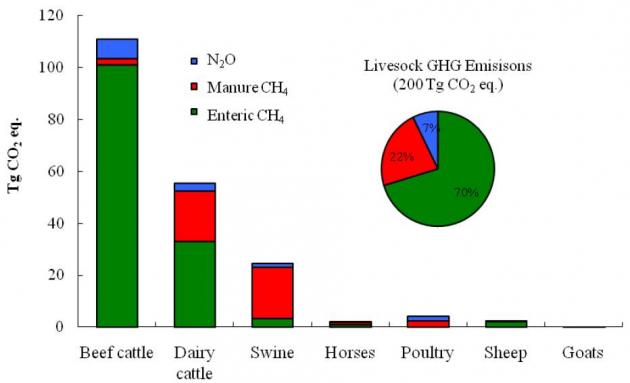How Much Waste And Methane From Farm Animals

Agriculture is both a source and sink for greenhouse gases (GHG). A source is a net contribution to the atmosphere, while a sink is a net withdrawal of greenhouse gases. In the Usa, agriculture is a relatively small-scale correspondent, with approximately 8% of the total greenhouse gas emissions, as seen below. About agricultural emissions originate from soil direction, enteric fermentation (the ruminant digestion process that produces methyl hydride), energy use, and manure management. The chief greenhouse gases related to agriculture are carbon dioxide, methane, and nitrous oxide. Within beast production, the largest emissions are from beefiness followed by dairy, and largely dominated by the methane produced in during cattle digestion.

U.S. greenhouse gas inventory with electricity distributed to economic sectors (EPA, 2013)

U.Southward. agricultural greenhouse gas sources ( Adjusted from Archibeque, S. et al., 2012 )

Greenhouse gas emissions from livestock in 2008 (USDA, 2011)
Soil Management
Excess nitrogen in agriculture systems can be converted to nitrous oxide through the nitrification-denitrification procedure. Nitrous oxide is a very potent greenhouse gas, with 310 times greater global warming potential than carbon dioxide. Nitrous oxide can be produced in soils following fertilizer application (both synthetic and organic).
As crops grow, photosynthesis removes carbon dioxide from the atmosphere and stores it in the plants and soil life. Soil and plant respiration adds carbon dioxide dorsum to the atmosphere when microbes or plants breakdown molecules to produce energy. Respiration is an essential part of growth and maintenance for nigh life on globe. This repeats with each growth, harvest, and decay cycle, therefore, feedstuffs and foods are by and large considered to be carbon "neutral."
Some carbon dioxide is stored in soils for long periods of time. The processes that effect in carbon accumulation are called carbon sinks or carbon sequestration. Ingather production and grazing management practices influence the soil'south power to exist a net source or sink for greenhouse gases. Managing soils in ways that increment organic affair levels can increase the aggregating (sink) of soil carbon for many years.
Animals
The next largest portion of livestock greenhouse gas emissions is from methane produced during enteric fermentation in ruminants – a natural role of ruminant digestion where microbes in the get-go of four stomachs, the rumen, interruption downwardly feed and produce methyl hydride as a past-product. The methane is released primarily through belching.
As with plants, animals respire carbon dioxide, but also store some in their bodies, then they too are considered a neutral source of atmospheric carbon dioxide.
Manure Management
A similar microbial process to enteric fermentation leads to methane production from stored manure. Anytime the manure sits for more than a couple days in an anaerobic (without oxygen) surroundings, methane will probable be produced. Methane tin can be generated in the animal housing, manure storage, and during manure awarding. Additionally, small amounts of methyl hydride is produced from manure deposited on grazing lands.
Nitrous oxide is also produced from manure storage surfaces, during state awarding, and from manure in bedded packs & lots.
Other sources
There are many smaller sources of greenhouse gases on farms. Combustion engines exaust carbon dioxide from fossil fuel (previously stored carbon) powered vehicles and equipment. Manufacturing of subcontract inputs, including fuel, electricity, machinery, fertilizer, pesticides, seeds, plastics, and building materials, also results in emissions.
To learn more than near how farm emissions are adamant and see species specific examples, run into the Carbon Footprint resources.
To learn nigh how to reduce on-farm emissions through mitigation technology and management options, see the Reducing Emissions resources.
Boosted Resources
Additional Brute Agronomics and Climate change Resources
Author: Crystal A. Powers, UNL
Reviewers:
Source: https://lpelc.org/greenhouse-gas-emissions-from-livestock-poultry/
Posted by: saulsfelf1971.blogspot.com

0 Response to "How Much Waste And Methane From Farm Animals"
Post a Comment